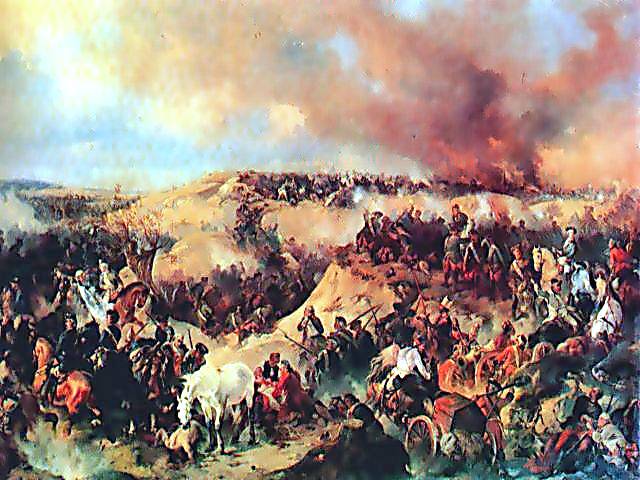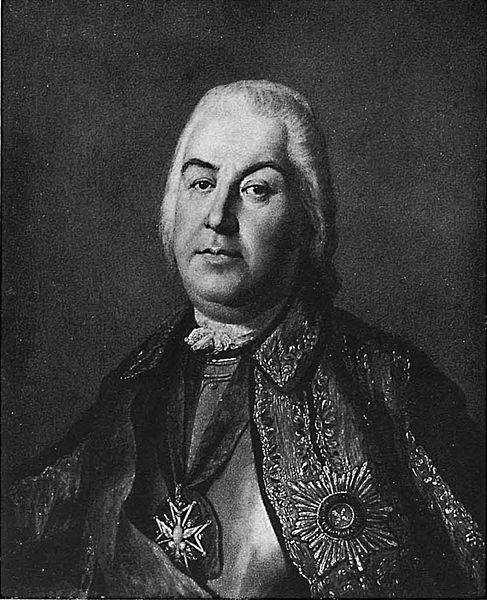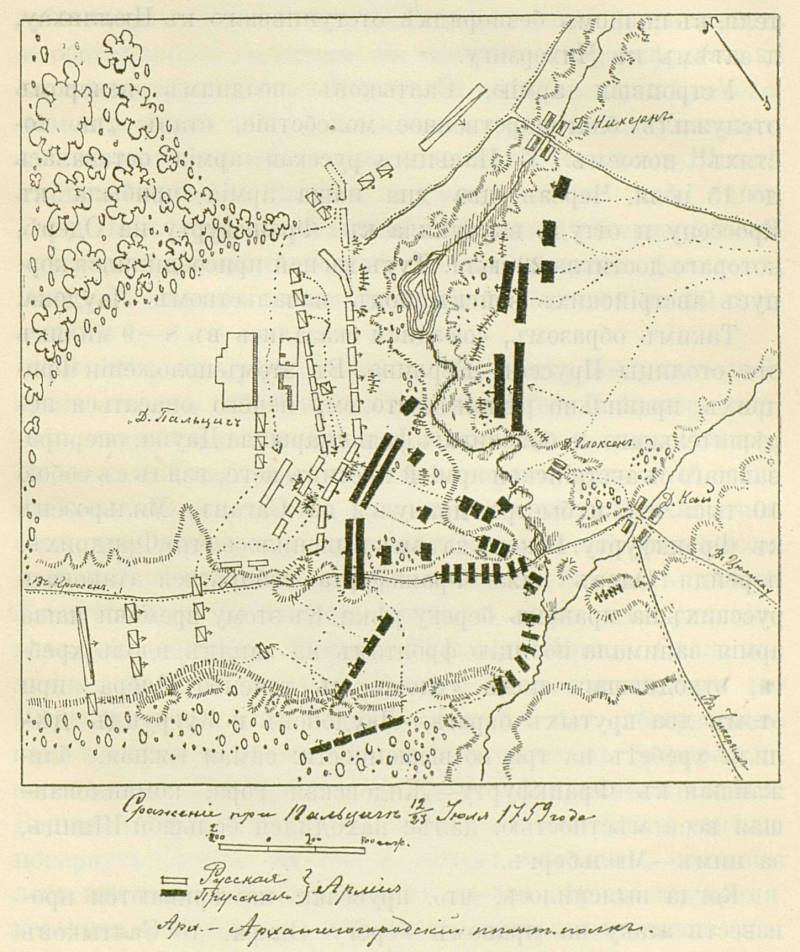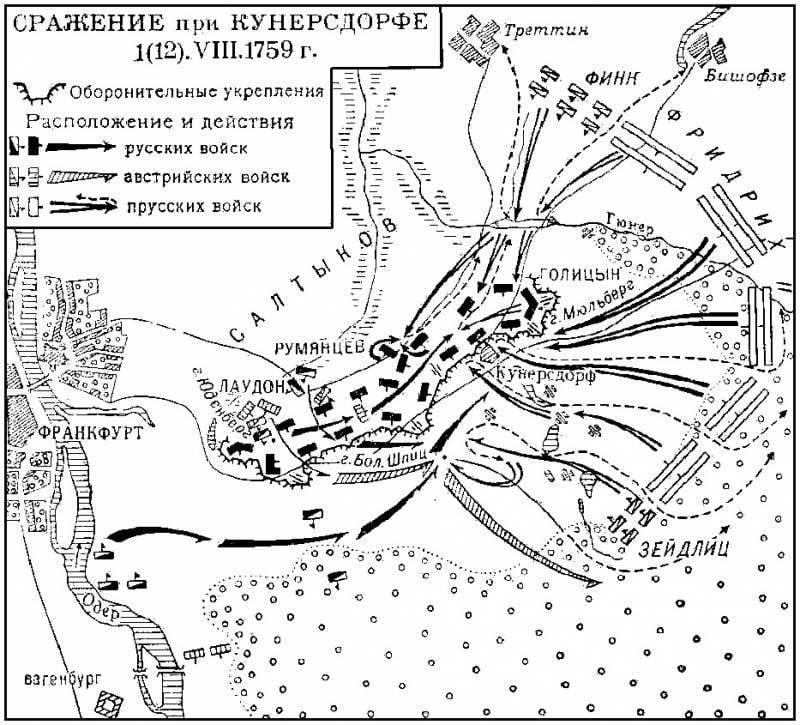Russian commander Saltykov. The defeat of the troops of the “invincible” Frederick the Great at Kunersdorf

1759 Campaign
1758 Campaign of the Year (Seven Years War) was for the Russian weapons favorable. The Russian army, under the leadership of Fermor, occupied East Prussia without a fight, including its capital, Königsberg. The Russian army in August gave the army of Frederick the Prussian battle at Zorndorf. The Prussian king was shocked. If at first he considered the Russians “barbarians”, stupid in military affairs, then Zorndorf (where he lost a third of the army) made him change his mind:
By the beginning of the 1759 campaign of the year, the Prussian army had lost part of its combat potential. Many experienced military generals and officers, old and experienced soldiers died. In their place they had to take everyone in a row, including prisoners, defectors and untrained recruits. Prussia was bloodless. Unable to conduct active offensive operations, Frederick abandoned the initiative and began to wait for the advance of the opponents in order to act on the basis of their situation. At the same time, the Prussian king tried to slow the advance of the allies (Russia and Austria) with the help of cavalry raids on the rear in order to destroy stores (warehouses) with supplies. At this time, the offensive of the majority of the army depended on supply, the destruction of stores led to the disruption of the campaign. In February, the Prussians raided the Russian rear in Poznan. The raid was successful, but did not cause much harm to the Russian army. In April, the Prussians raided the rear of the Austrians. He was more successful, the Austrian main apartment (headquarters) was so scared that it refused active operations during the spring and early summer of the 1759 year.
Meanwhile, the St. Petersburg Conference (Supreme Political Council), which was under the complete influence of Vienna, developed a campaign plan for the 1759 of the year, according to which the Russian army became auxiliary to the Austrian. The army was planned to be brought up to 120 by thousands of people and most of it should be moved to the aid of Austria, and the smaller part left on the lower Vistula. At the same time, the commander-in-chief was not at all told exactly where to connect with the Austrians. However, the army could not be brought up to half the planned strength. Due to the insistent requests of the Austrians, the army had to start moving before the arrival of replenishment. In May 1759, General Peter Saltykov was unexpectedly appointed commander in chief of the Russian army. Fermor received one of the three divisions.
Victory near Palzig
Saltykov was instructed to connect with the Austrians. In July, 40 thousand of the Russian army marched west to the Oder River, in the direction of the city of Krosen, planning to unite there with the Austrian troops of Down. Frederick II, confident in Down's indecision, transferred thousands of soldiers from the Austrian front to the Russian 30, who were to defeat them before the allies joined. The Prussian troops were commanded first by Manteuffel, then by the Don, and finally by Vedel. But they acted passively and missed the opportunity to attack the Russian army.
The Prussian king, dissatisfied with the actions of General Don, replaced him with Wedel and ordered the new commander to prevent the Russians from forcing the Oder in the Crossen area at all costs. Wedel had 30 infantry battalions, 63 cavalry squadron, in total over 27 thousand people (18 thousand infantry and more than 9 thousand cavalry) and 56 guns. Saltykov's troops totaled 40 thousand people with 186 guns.
The battle took place on 12 (23) on July 1759 of the year near the town of Palzig. Wedel poorly organized intelligence and made a mistake in the location of the Russian troops. The Prussian general planned to attack the enemy on the march on the road to Crossen. At the same time, he planned before the Russians to take an advantageous position on the heights of Palzig. However, the Russian troops were ahead of the enemy and occupied heights in 13 hours. Having occupied Palzig, the Russians discovered the movement of the enemy. Saltykov echeloned the troops in depth. The Russian commander advanced Fermor's division into the first line, and the Golitsyn Observatory Corps and the Totleben cavalry were located on the left flank. The second line was Vilboa’s division, cuirassiers of Eropkin, the reserve was commanded by General Demik. Most of the artillery was located on the right flank, where they feared the main blow of the enemy. From the flanks, the position was covered by forests and the Prussians could attack only from the front.
Having discovered the Russians in front of him, Vedel was sure that it was only the advanced forces of the enemy and decided to attack. Generals Manteuffel and von Gülsen advanced on the right wing, Stuterheim on the left. Kanitsa’s troops were sent to bypass the rear of the Russians to capture Palzig. The offensive began without artillery preparation. The troops of Manteuffel and Gülsen immediately came under heavy artillery fire, one after the other the Prussian attacks were repelled. Prussian troops suffered serious losses. Gulsen was able to break through to the center of the Russian position, where he was finally defeated in a fierce hand-to-hand combat. Manteuffel was seriously injured. On the left Prussian flank, Stuterheim was immediately defeated. Kanitsa’s attempt to bypass Russian positions was immediately thwarted by Totleben's cavalry. Kanitsa’s next attempt to break through was also repelled. As a result, Shorlemer’s cuirassiers were able to break through to the second line of the Russian army. But here they were stopped by the troops of Eropkin and Demika (he fell in battle).
In 19 hours the battle ended with the defeat of the Prussian army. Wedel troops lost up to 9 thousand people (7,5 thousand killed and wounded and 1,5 thousand deserters). Russian losses - over 4,7 thousand people. Russian morale has increased significantly. According to the testimony of A. writer Bolotov (he fought in Prussia during the Seven Years War): “the troops, who defeated the enemy, became encouraged and began to hope more to rely on the old man, who had already fallen in love with his soldiers”. Unfortunately, Saltykov did not bring the matter to the complete destruction of the defeated and demoralized Prussian army. He did not pursue the enemy. Wedel was able to calmly withdraw the remnants of the troops to the other side of the Oder.
All this time the Austrians were inactive. The Austrian Commander-in-Chief Down based his plans on Russian blood. He was afraid to engage in battle with the “invincible” Frederick, despite the fact that he had a double superiority in power. The Austrian command tried to draw the Russians to itself, in the depths of Silesia and expose them to the first blow of the Iron Prussians. However, the old veteran Saltykov saw through his Austrian "partners" and did not succumb to this strategy. He decided to go to Frankfurt and threaten Berlin.
This movement of the Russian army equally troubled both the Prussians and the Austrians. Friedrich was afraid for his capital, and the Austrian commander, Down, was afraid that the Russians would win without him, which could have important political consequences. The Prussian monarch rushed with the army to defend Berlin. But Down, not daring to attack the weak Prussian barrier left against him, sent Laudon's corps to Frankfurt to get ahead of the Russians and get a ransom from the townspeople. However, this calculation was not justified, the Russians occupied Frankfurt first on the 20 (31) of July. A few days later the Austrians approached. Having occupied Frankfurt, Saltykov was going to move Rumyantsev with cavalry to Berlin, but the appearance of the army of Friedrich there forced him to abandon this plan.
Kunersdorf battle
After joining the Laudon corps, the Russian commander in chief had 58 thousand people (41 thousand Russians and 18,5 thousand Austrians), 248 guns with which he took a good position with Kunersdorf. The troops were located on the three dominant heights (Mühlberg, Bol. Spitz, Judenberg), separated from each other by ravines and a swampy lowland, it was strengthened by trenches and artillery batteries on the tops of the hills. On the one hand, the position was convenient for defense, on the other hand, it was difficult to maneuver forces and reserves, and render assistance to neighbors on time. At the same time, it is worth remembering that the Russians had 33 thousand regular troops, and 8 thousand irregular (Cossacks and Kalmyks).
As a result, Frederick with his 50 thousand army in the Berlin area was in a dangerous situation. 58 thousand Russian-Austrian army of Saltykov attacked from the east, it was in 80 versts from Berlin. In the south, at 150 versts from the metropolitan area, 65 thousand Down army was located, in the west, at 100 versts, 30 thousand Imperials stood (Imperial Union of Germany - the union of small German states that fought against Prussia). The Prussian king decided with all his might to hit the most dangerous enemy, who was the most advanced and was not used to dodging the battle.
The Prussian king with 48 thousand troops (35 thousand infantry and 13 you. Cavalry) and 200 guns. 30 — 31 July (10 — 11 August) The Prussians crossed the Oder north of Frankfurt in order to strike the rear of the Russian troops, as under Zondorf. 1 (12) On August 1759, the Prussians went on the attack. However, Saltykov was not Fermor, he turned the front around. The Russian army was heavily echeloned in depth on a relatively narrow front. The Prussian troops were able to bring down the first two lines, occupied the height of Mühlberg on the left flank, capturing guns up to 70, but then their attack choked. Their attacks on Bol. Spitz were repulsed. The bloodless, weary Prussian infantry lost their shock capabilities. Saltykov in time strengthened the center, sending reinforcements here from the right flank and reserve. Seydlitz cavalry was defeated, rushing to the still unsettled Russian infantry. Frederick threw everything he had into battle, but all the attacks were repelled. The Prussian army was upset and suffered heavy losses. Then the Russians launched a counterattack and overthrew the enemy with a powerful blow. Rumyantsev's cavalry finished off the running Prussians.
In fact, the Prussian army ceased to exist, losing up to 20 thousand people and almost all of the artillery. Thousands of soldiers fled the army after the battle, deserted. Russian losses - 13,5 thousand people, Austrian - 2,5 thousand soldiers. Friedrich of Prussia was desperate, he wrote the next day: “I don’t have 48 thousand from the army at that moment and 3 thousand. Everything is running and I have no more power over the army ... The consequences of the battle will be even worse than the battle itself: I there are no more means and, to tell the truth, I consider everything lost ... ”Friedrich even temporarily resigned as commander in chief.
Austrians save Frederick
After the battle, Saltykov left no more than 22 — 23 thousand people. The Austrians of Laudon obeyed him only conditionally. Therefore, the Russian commander in chief could not complete the campaign by taking Berlin and ending the war.
The Austrian army of Down could finish off the Prussians and end the war. However, the Austrians did not go on the offensive when Prussia did not have the strength to fight back. They only continued to interfere with the Russians. Meanwhile, Frederick II came to his senses after the disaster at Kunersdorf, and gathered a new 33 thousand army from Berlin. The inaction of the Austrians saved Prussia from a military catastrophe.
The Austrian command persuaded Saltykov to go to Silesia to go to Berlin together. But as soon as the Prussian hussars again marched along the Prussian rear, so Down hastily retreated. Russian Austrians promised supply, but deceived. Angry Saltykov decided to act independently and moved to the Glogau fortress. Friedrich's army moved parallel to Saltykov with the goal of preempting him. Friedrich and Saltykov had 24 thousand soldiers each, and both sides decided this time not to enter the battle. Saltykov decided not to risk being in 500 versts from the supply and reinforcement bases. Friedrich, remembering the bloody lesson of Kunersdorf, also did not dare to battle. In September, the opponents dispersed. The Russian army went to winter apartments. Field Marshal Saltykov refused the Conference’s proposal to please the Vienna Court in winter together with the Allies in Silesia.
Thus, the 1759 campaign of the year and Kunersdorf could decide the outcome of the Seven Years War and the fate of Prussia. Fortunately for Berlin, the Russian army fought in the interests of Vienna. The Austrians were afraid of the victory of the Russians. The mediocre and passive Austrian commander, Down, missed or deliberately refused the opportunity to finish off Prussia and end the war in Europe.



Information